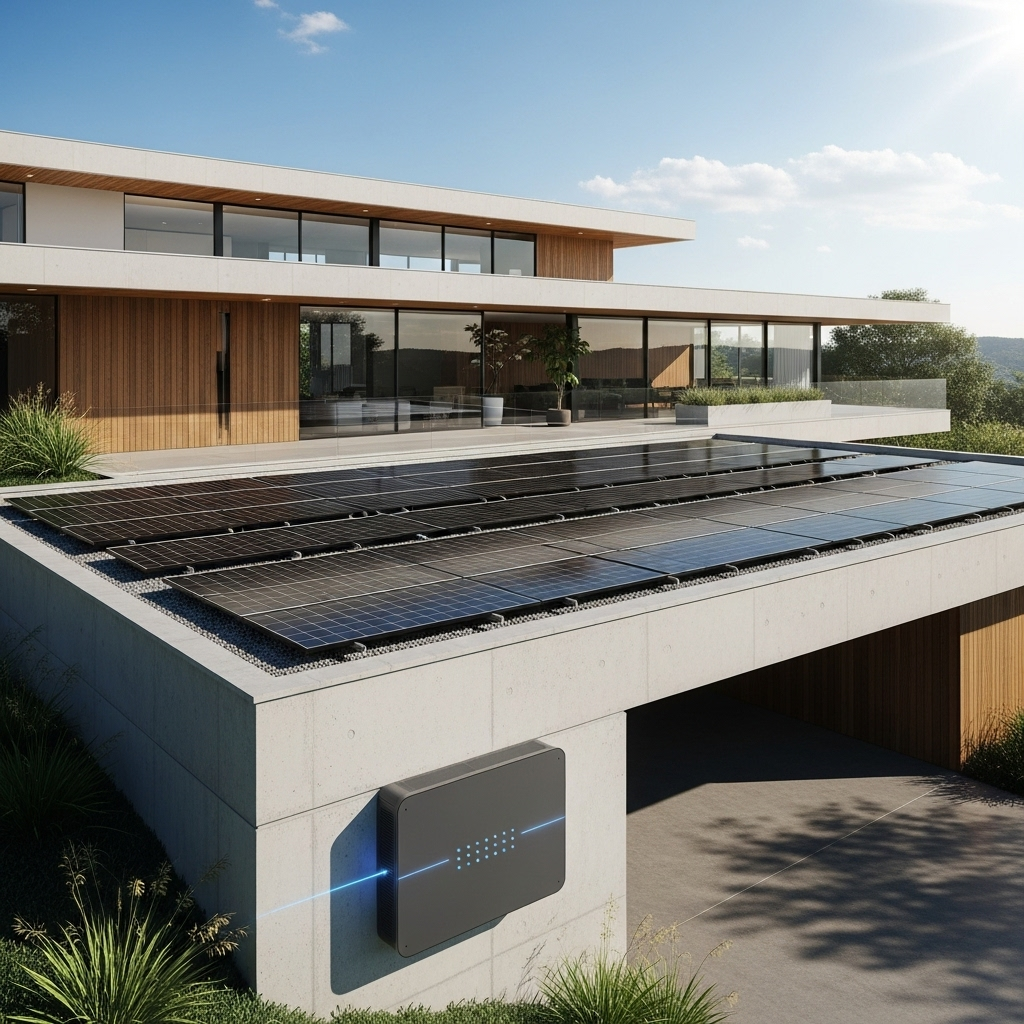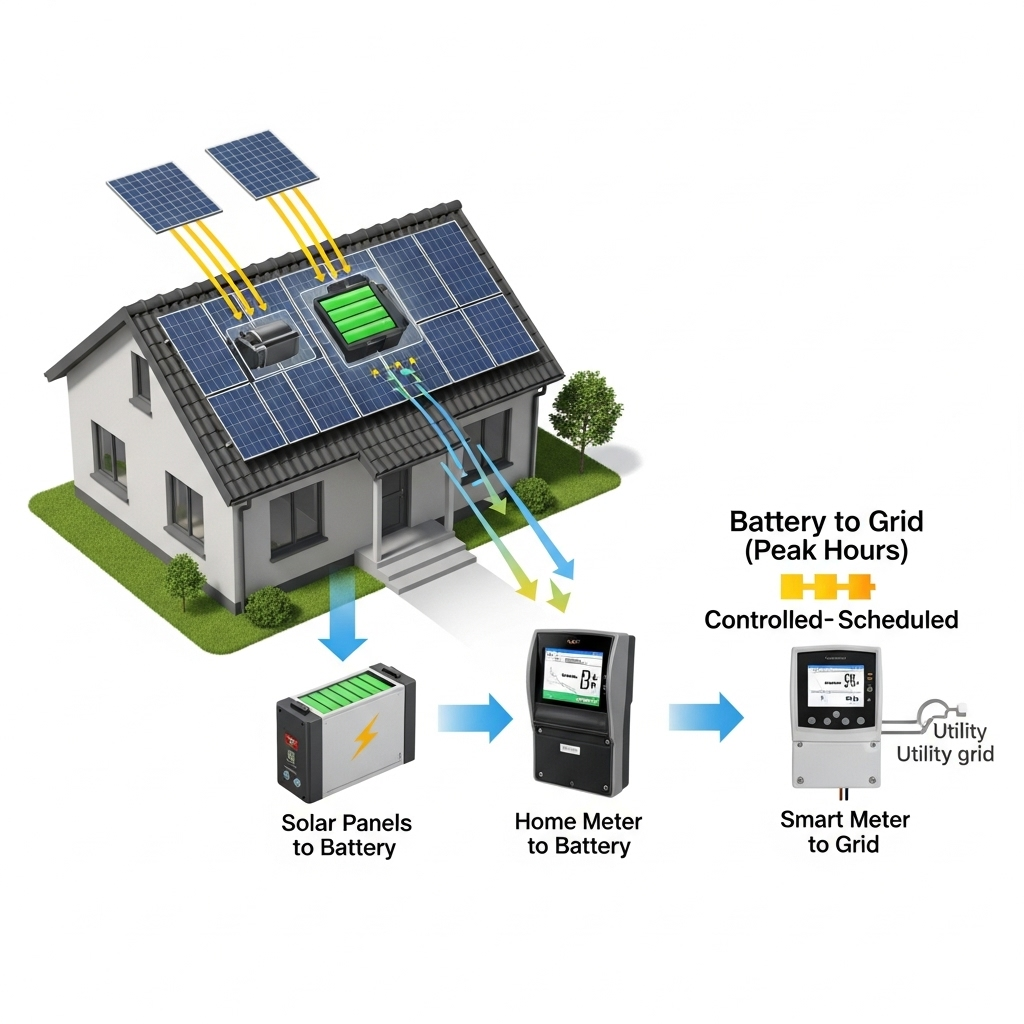India's rooftop solar (RTS) sector is a landscape of immense potential and complex challenges. At the heart of its growth story lies a critical policy debate: the choice between net metering and gross metering. While these mechanisms were designed to encourage solar adoption, they created significant financial and operational hurdles for the nation's power Distribution Companies (DISCOMs). This analysis examines the experiences of Indian DISCOMs and the lessons learned, pointing toward a more sustainable future for solar compensation.
The Foundational Models: Net and Gross Metering in India
Since 2013, Indian states have implemented various policies to compensate rooftop solar system owners. The two dominant models have been net metering and gross metering, each with distinct implications for consumers and utilities.
How Net Metering Works
Net metering allows a solar system owner to first use the electricity they generate, reducing their direct consumption from the grid. Any surplus power is exported to the grid, and the owner receives energy credits. These credits can be used to offset electricity imported from the grid at a later time. Most Indian states implemented monthly or annual settlement periods. This system is attractive for consumers, as it effectively allows them to use the grid as a storage bank. However, this structure can create financial pressure on DISCOMs, as it doesn't always encourage real-time self-consumption.
The Gross Metering Approach
Under gross metering, the structure is different. All electricity generated by the solar system is exported directly to the grid at a predetermined feed-in tariff (FiT). The property owner then buys all the electricity they need from the DISCOM at the standard retail rate. This model provides a predictable revenue stream for the solar owner and the DISCOM but disconnects the act of generation from consumption. It provides little incentive for owners to align their energy usage with solar production.
A Patchwork of Regulations
A significant challenge in India has been the lack of regulatory consistency across states. To address this, the central government introduced the Electricity (Rights of Consumers) Rules in 2020. As detailed in the IEA report, Unlocking the Economic Potential of Rooftop Solar PV in India, these rules attempted to create some uniformity by allowing net metering for systems up to 10 kW and mandating gross metering for larger installations. Despite this, many state-level differences remain.
The DISCOM Dilemma: Financial Strain and Grid Challenges
While intended to spur solar growth, the initial rollout of these policies, particularly net metering, placed unforeseen burdens on India's DISCOMs. Their experience offers valuable lessons for regulators worldwide.
Revenue Erosion from Key Customers
DISCOMs in India operate on a cross-subsidy model, where commercial and industrial (C&I) customers pay higher tariffs that help subsidize lower rates for residential and agricultural users. Rooftop solar is most financially attractive to these C&I customers. Under net metering, as these high-paying customers reduced their grid purchases, DISCOM revenues fell sharply. This revenue reduction is a significant concern, as the IEA's analysis points out that this structure has had an adverse impact on the revenues of DISCOMs, threatening their financial stability.
Grid Management and Stability Concerns
Large-scale, unmanaged solar generation can introduce instability into the local distribution grid. On sunny afternoons, a high concentration of solar systems can push a large amount of power back into a grid not designed for two-way flow. Traditional net metering, by allowing credit banking, provides no incentive for users to consume power when it's generated. This mismatch can lead to voltage fluctuations and requires costly grid upgrades, a burden that often falls on the DISCOM.
Evolving Policies: The Path to a Balanced Solution
The challenges faced by DISCOMs have prompted a policy evolution. The focus is now shifting toward models that better balance consumer benefits with utility stability, primarily by encouraging self-consumption.
The Rise of Net Billing
Net billing is emerging as a popular alternative. In this model, self-consumption is still the priority. The key difference is in how exports are compensated. Instead of a 1:1 credit at the retail rate, exported energy is credited at a lower rate, such as the wholesale electricity price or the DISCOM's 'avoided cost' of generation. This approach more accurately reflects the value of that energy to the utility and encourages solar owners to use as much of their own power as possible.
The Critical Role of Energy Storage
With export compensation rates declining under net billing, maximizing self-consumption becomes the most effective strategy for solar owners. This is where home battery storage systems become invaluable. A battery allows you to store excess solar energy generated during the day and use it during the evening or on cloudy days. This dramatically reduces your reliance on grid imports and minimizes low-value exports. Maximizing self-consumption is not just a concept; it's a measurable strategy. Understanding key metrics like depth of discharge (DoD) and round-trip efficiency is fundamental to selecting the right system. For a detailed breakdown, the ultimate reference on solar storage performance provides a comprehensive look at how these factors influence your system's long-term value.
Lessons for Future Policy Design
The Indian experience shows that effective solar policy must be a three-way balance. Improving these policies is key to aligning the interests of consumers, DISCOMs, and regulators. The IEA and CEEW workshop report suggests several improvements, including optimising net and gross metering rules to promote self-consumption and ensure attractive returns for all consumer segments. This includes designing smarter remuneration rules and streamlining administrative processes.
Comparing Solar Compensation Models
The table below summarizes the key differences between the three primary compensation structures.
| Feature | Net Metering | Gross Metering | Net Billing |
|---|---|---|---|
| Export Compensation | Full retail rate credit | Fixed Feed-in Tariff (FiT) | Below retail rate (e.g., wholesale price) |
| Incentive for Self-Consumption | Low | Very Low | High |
| Impact on DISCOM Revenue | High negative impact | Predictable, but can be costly | Moderate, more balanced impact |
| Primary Beneficiary | Consumer | Grid/Utility (if FiT is low) | Both Consumer and Utility |
Disclaimer: This information is for educational purposes only and does not constitute financial or investment advice. Solar policies and tariffs vary significantly by state and utility.
A Balanced Path for India's Solar Future
The journey from traditional net metering to more sophisticated compensation models in India reflects a maturing solar market. The initial, simple policies were effective in kickstarting adoption but proved unsustainable for utilities. The lessons learned have paved the way for smarter frameworks like net billing, which, when paired with energy storage, create a win-win situation. For homeowners, this combination unlocks greater energy independence and savings. For DISCOMs, it supports a more stable, resilient, and financially viable grid. This balanced approach is the key to unlocking the full economic and environmental potential of rooftop solar across India.
Frequently Asked Questions
What is the main difference between net metering and gross metering in India?
The primary difference lies in how solar energy is accounted for. With net metering, you use your solar power first and export only the surplus, receiving credits for it. With gross metering, you export all your solar power to the grid for a fixed payment and buy all the power you need from the utility company.
Why are DISCOMs in India often hesitant about net metering?
DISCOMs have been hesitant because net metering can cause significant revenue loss. Their highest-paying commercial and industrial customers adopt solar, reducing their electricity bills and cutting into the utility's revenue. This impacts the DISCOM's ability to cross-subsidize rates for other customers and can lead to financial instability.
How does adding a battery storage system help with new solar policies like net billing?
Under net billing, you get paid less for the electricity you export to the grid. A battery storage system allows you to store your excess solar energy instead of exporting it for a low rate. You can then use this stored energy in the evening, maximizing self-consumption and drastically reducing the amount of expensive electricity you need to buy from the grid. This makes your solar investment more profitable.
What is the current rule for solar system capacity under net metering in India?
According to the 2020 Electricity (Rights of Consumers) Rules, net metering is generally applicable for rooftop solar systems with a capacity of up to 10 kW. For systems with a capacity larger than 10 kW, gross metering is typically mandated. However, specific rules and implementation can still vary between different states.





Leave a comment
All comments are moderated before being published.
This site is protected by hCaptcha and the hCaptcha Privacy Policy and Terms of Service apply.